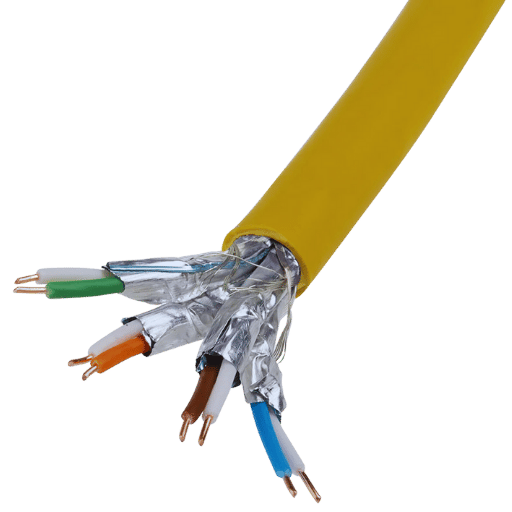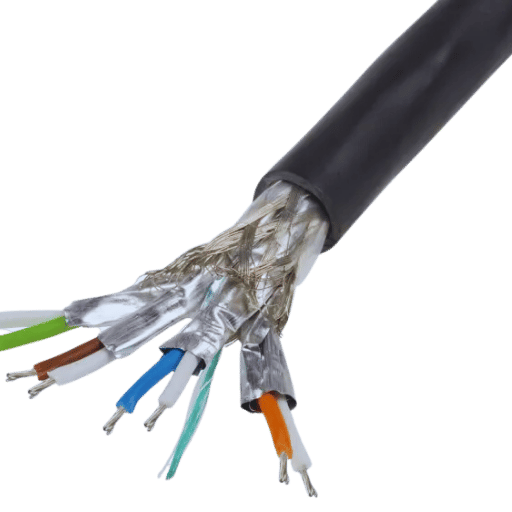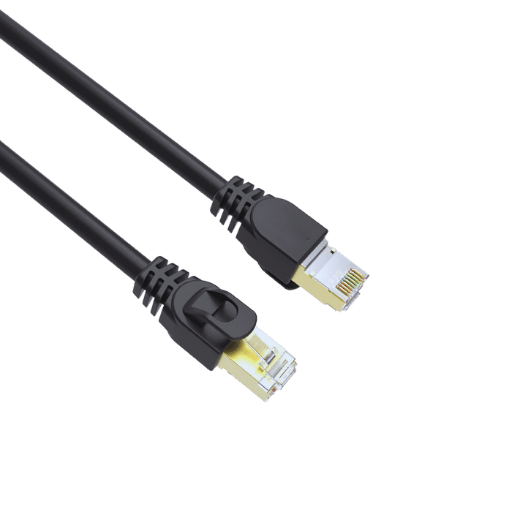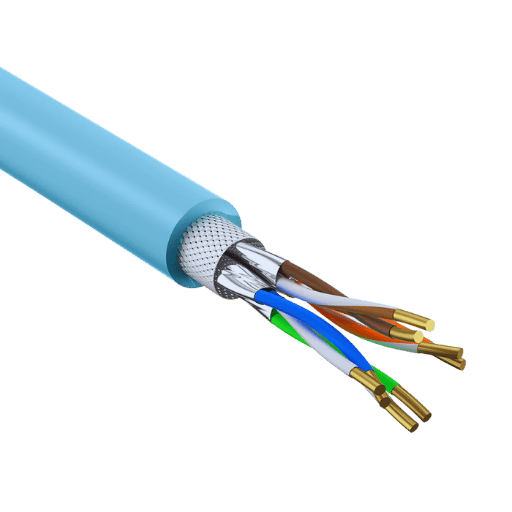The need for a convenient and fast Internet connection has never been greater than in the contemporary digital society. The category of the Ethernet cable that is used is among the various factors that guarantee smooth data transfer. Out of that wide range of Ethernet cables, CAT 7 Ethernet cables tend to be the most unique from the rest when it comes to performance and technological aspects. The purpose of this article is to look into the details surrounding CAT 7 Ethernet cables as well as their technology, specifications, strengths, and possible uses. Regardless of whether you belong to the group of a Network professional or a tech lover, the decoding of the whole concept of CAT 7 cables will empower you to make the right decisions in the implementation of strong network platforms.

Cables for VSI terminals of the CAT 7 standard are referred to as shielded twisted pair twisted pair assemblies which work with the Ethernet and other network subnet levels. The maximum frequency range is up to 600 MHz, and the maximum data transfer rate is 10 Gbps for a distance of up to 100 meters. CAT 7 cables are also designed with heavy shielding to prevent cross-talk and EMI and provide excellent performance and stability in high-end computer network systems.
Category 7(CAT 7) Ethernet cables. Instructions for Use: All essays. CAT 7 cables manage to transfer data at rates of their very own 10 Gbps, reaching 100 meters maximum length. These cables are used at a frequency of 600 MHz, so interference and crosstalk are kept to a minimum. S/FTP (Shielded/Foiled Twisted Pair) is the type of shielding used for your cables and it includes shielding for each separated transmitting pair and overall shielding as well. CAT 7 connectors GG45 are designed for this cable type; also, standard RJ45 is acceptable. In essence, these wires are very much applicable when massive data centers or corporate networks are created as they comply with ISO/IEC 11801 standard for CAT 7 wires.
If we compare CAT 7, CAT 6 and CAT 8 the comparison should focus on use and performance specifications of the three. As far as CAT 6 cables are concerned, these rated to a speed of 1 Gbps and a frequency of 250 MHz are more suitable for general-purpose cabling, which is still less than the top-level performance of the CAT7 cables. At the other extreme, CAT 8 cables work at a frequency of 2000 MHz and support data transfer rates up to 40 Gbps, which are targeted for high-end applications that include data centers that are very bandwidth-hungry and with very low latency requirements. Just as in the advances advanced coping strategies, CAT 7 cables provide a better option where 10 gigabit is achievable with up to 600 Mhertz and a more advanced center frequency 40-degree deflection. Another unit of measure with thick center frequencies and lower external interference could be based on enough acceptable interference such that temporal correlation reconstruction approximations are plausible sedimentation.
The construction of CAT 7 Ethernet cables presents benefits that have become strategically commendable for developing network structures. First, all individual and overall shielding within the cables prevents a lot of electromotive interference (EMI) to ensure the data transmissions are stable and reliable. Second, CAT 7 cables are capable of working at a maximum data throughput rate of 10 Gbps at a frequency bandwidth of 600 MHz, which is acceptable for data transfer applications. Also, their GG45 and RJ45 connector back designs make it easy to use CAT 7 cables with the existing network. Most importantly, CAT 7 cables have conquered a number of high-quality performance standards compliance, such as the ISO/IEC 11801, which can stand for reasonably extended periods, providing a suitable match for enterprises and data centers.

While purchasing a CAT 7 cable, take into account the following:
It is important to emphasize the necessity of knowing the types of cable shielding available for CAT 7 cables in order to gain improved performance within the given area. Two of the most common types of shielding are:
Although each of these shield types improves the performance of the signal by preserving its integrity, the application of the optimal shielding type is dictated by the intensity of EMI present in the environment or the requirements of the given application.
In case one is attempting to choose between CAT 7 Ethernet patch cables and bulk Ethernet cables in a certain way, some factors would have to be taken into account as follows:
Use Case:
Installation:
Cost:
Flexibility:
To conclude, specific requirements such as network installation, project scale and budget tend to define the selection between the CAT 7 Ethernet patch cables and the wholesale Ethernet cable.

Essential Tools and Materials
Method

The CAT 7 Ethernet cables’ construction allows them to retain compatibility with previous generations like the CAT 5e and CAT 6, which makes them usable with many routers and modems. In addition, ensure that the router or modem has got at least gigabit ethernet if one is to get the full benefits offered by the minimal interference and higher bandwidth of CAT 7 cables. Last, check the compatibility of the connectors too; typically, CAT 7 cables would be using GG45 or TERA connectors, but standard RJ45 is also supported, providing her dominance over existing machines.
Gigabit Ethernet:
Also known as Gigabit Ethernet, Gigabit Ethernet gives a data transfer rate of 1 gigabit every second, which is also equal to one thousand megabits every second. This type of connectivity is sufficient for the majority of the residents and the small businesses that require adequate bandwidth for streaming HD videos, gaming, file transferring, etc. The harmonious support of the CAT 7 cables with GbE provides very low delays and low crosstalk hence making them suitable for such network systems.
10 Gigabit Ethernet:
It is ten times faster than Gigi bit Ethernet, and therefore, 10GbE leveraged the potential of the network infrastructure in billions of bytes with the maximum speed of 10Gbits. Various applications such as conferencing and cloud computing and the usual operations of data centers are supported by this tenfold increase in GbE. CAT 7, with its construction and additional shielding, is designed to withstand the higher frequencies used in 10GbE, and thus, minimization of crosstalk and EMI are achieved.
How Gigabit Ethernet Became Outdated
Ongoing efforts to develop new generations of Ethernet standards strive to be even higher with the focus on 25GbE, which is most often used in enterprise and data center environments, as well as 40GbE and 100GbE. Such higher bandwidth solutions are necessary for the modern applications of machine learning, big data analysis, virtual reality, and others, which lead to ever-expanding data set requirements. However, while such CAT 7 cables are able to provide these advanced speeds, he points out, there are other newer standards, such as CAT 8, which were made in mind to work in high-performance networks.
Finally, these handle all Ethernet standards particularly Ethernet cabling in porcelain provided information concerning the advantages and shortcomings of each type of Ethernet cabling therefore great decisions are reached when designing and improving any network topology. For sites that are happy with the present level of gigabit and 10 gigabit performance, CAT 7 is more than adequate. For ambitious customers who want to go beyond 10 gigabit performance, there are adequate solutions.
There are several measures that you can take to make sure that your CAT 7 Ethernet cable functions optimally in its usage. This is done using a network cable tester, which will check if a major line disruption is present, such as an open circuit, short circuit, or miswiring. A cable tester is a device used to test the installation of an electrical cable in the system. It can quite rapidly confirm that the cough is functioning normally and all the pairs are carrying active data.
In the second instance, a performance testing tool should be used for the actual measurement of the data speeds. This can be achieved by using software tools such as iPerf or LAN Speed Test which can be put to use from the devices at each end of the cable to test the backwards the data transfer in Gbps. This step will ensure that the expectations of the performance level of the cable of 10Gbps and above will be satisfied.
Last but not least, perform flare up network tester for more critical observation. These devices, in particular, not only can measure the speed and connectivity, but also evaluate the quality of the signal and find factors that may cause disturbances. Proper maintenance has to be done hence and from the use of CAT 7 Ethernet cable, high performance can be obtained for both existing and future network expectations.

Taking appropriate care of your CAT 7 Ethernet cable guarantees its affordable repairs and uncompromised employment for as long as possible. As a result, several suggestions are included:
Intermittent Connectivity:
Slow Network Speeds:
No Connection:
Signal Degradation:
Physical Damage:
In order to enhance the performance and reliability of your network, a change or upgrade to either or all of the network cablings will in several instances be necessary. First, let’s talk about upgrades when evaluating consistent issues with the network such as little speeds, apostasy of connection and frequent outages. Such problems are possibly symptoms that the present cables are old or they are worn out.
Also, in the case where the obtainable cabling does not go beyond a certain level, say CAT 6 or CAT 7, and a much better arrangement of such cabling being implemented, it would considerably improve the performance of their network, in this case upholding more data rates and less signal attenuation. Also, if there are plans to enlarge the network or include the technologies that entail high bandwidth, it would be prudent to replace cabling standards to the newer versions to avoid obsolescence of such infrastructure.
Finally, cleaving such cables may be agony-reducing, and it may not be possible to carry out the repairs on the oio cables twisted over a long period. if a persistent thin is inducing fraying hence, the replacement of such cables can adequately restore normal network operations. Make a habit of testing and computing the states of your cables overboard to understand whether or not it is necessary to advance in order to keep up with the trends in the network.
A: The Cat 7 Ethernet cable is a type of high quality t wire made of shielded twisted pairs that guarantees no degradation of the signals sent carrying Ethernet signals of up to 10 Gbps. This means that it works well within bandwidths of up to 600MHz and can still work together with Cat6 and Cat5e cables.
A: Above all, Cat7 cables are better than their predecessors with regards to the bandwidth and the frequency of operation which is up to 600MHz as opposed to 250MHz for Cat6 and Cat6a. Such reduction in interference in turn results to better data transfer speeds as well as improved working conditions under high demand network usage.
A: Yes, Cat7 outdoor Ethernet cables are made for this purpose. There are outdoor cat 7 Ethernet cables that are weatherproof and are much more robust than their regular counterparts and can directly be buried for permanent outdoor installations.
A: Other than being able to transmit data at rates exceeding 10 Gigabits per second, the Cat7 cables have efficient shielding and cover higher bandwidths can operate up to 600 Mhz. Cat5e and Cat6 cables have much lower speeds and lower shielding than Cat7 making performance applications favor Cat7 cables.
A: The answer is yes. The Cat7 cables have standard RJ-45 connectors that fit well. However, it is preferable to use shielded RJ-45 connectors in order to protect and uphold the structure of the cable.
A: Shielded Ethernet patch cables are required wherein the operating site contains high electromagnetic interference (EMI) or radio frequency interference (RFI). These cables are of additional benefits and enhance proper network functionality.
A: I can even say that Xbox has a good reinforcement of Cat7 cables. In that, it provides fast and efficient interface, therefore absence of lag hence better gaming.
A: Cat7 bulk cables are manufactured in a range of lengths to accommodate all requirements. Standard measurements may include 10 ft, 25 ft, 50 ft, 100 ft etc so that the installation can be tailored to meet the different needs.
A: It is worth mentioning that Cat7 cables are used as patch cord in home networks as well. The best feature of it is that it is capable of fast communication and protection against external electromagnetic interference which is useful when connecting computers, routers and switches.
A: Data rates in Cat8 Ethernet cables go up to 40Gbps and their operating frequencies go up to 2000MHz which is higher than Cat7. However, versatility and sufficient performance for most of the home and business application joins Cat7 Ethernets to Cat8 Ethernets.